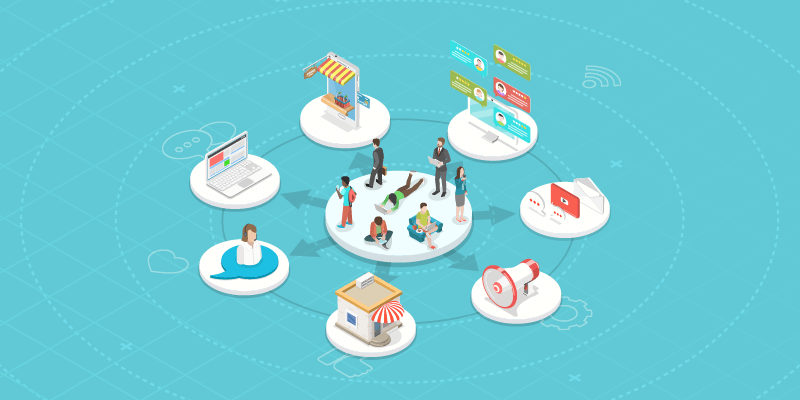Omnichannel retailing is now an essential component of every retail strategy. Customers want to be able to smoothly move from looking on a mobile device to picking up an item in-store in today’s retail environment. The ideal omnichannel retail strategy eventually results in an experience that allows customers to seamlessly transition from one channel to another. Here, we’ll learn how omnichannel retailing works, as well as its benefits.
What Is Omnichannel Retailing?
Omnichannel retailing is a completely integrated approach to commerce that provides customers with a consistent experience across all channels and touchpoints, including web, in-store, and in-app. The purpose of omnichannel retailing is to give customers a convenient experience throughout their shopping experience.
A good omnichannel retailing strategy allows customers to select their preferred transaction place while also making cross-channel transfers easy for them. Indeed, 14% of customers will increase their spending after being given an omnichannel strategy: the proof is in the revenue.
Inventory, customer service, and sales experience must also be consistent across numerous channels. Recent advancements in IT infrastructure and data analytics have enabled customers’ journeys to be tracked across various touchpoints, from social media ads and interactions via the website, app, chat, customer care calls and email, and eventually back to the physical store.
Omnichannel vs. Multichannel Retailing
Before omnichannel retail, there was multichannel retail, which meant that all of the different channels existed, but they were separate and unconnected. Customers may simply switch from one channel to another thanks to the rise of omnichannel retail, which is aimed to roll up into one overarching brand experience.
How to Create an Omnichannel Retailing Strategy
With the rise of omnichannel shopping, brands, and businesses must reconsider their strategy in order to satisfy the demands of today’s empowered customers and deliver the most appealing, frictionless, consistent, and contextual experiences across all channels.
#1. Map consumer purchasing habits
Customer behavior and customer journeys are more complex in the multichannel arena. Purchases can be made at any time of day or night, depending on numerous affecting circumstances, either directly at physical stores or online businesses. This necessitates the development of solid omnichannel strategies that take into account the various consumer routes and influencers across all media. Understanding the decision-making process of the customer is critical for building an omnichannel strategy.
Gathering insights around some key topics can assist merchants in clearly mapping out customer journeys so that they can completely understand their customers’ preferences and wants and give the most appropriate experience at the right moment. To create such experiences, physical retailers can use technologies like iBeacon, which give an excellent approach to delivering tailored, contextual, and hyper-local experiences to customers on their smartphones while in the store, while also collecting significant user data.
#2. Increase customer engagement
Following an awareness of customer behavior (as determined by the questions in the preceding section), retailers should create detailed customer route maps in order to set up relevant triggers across channels. Such triggers should attempt to increase client engagement and promote purchases. Here are a few examples of customer triggers that can be used:
- Hold events and hold sales – Events and sales have a high customer memory and can be utilized to remind people to buy. This also serves as a shopping objective.
- Send proximity notifications – Retailers can send highly customized messages to customers based on their location in the shop. Such a notice can be very relevant and result in better conversions.
- Send offers/discount reminders – Notifications about a special discount or the quantity of acquired loyalty points might serve as an excellent trigger for completing purchases.
- Start a conversation – In order to increase brand value, retailers and brands can engage in active discourse on social media platforms.
Using triggers effectively can help brands not only generate customer engagement but also build long-term brand value.
Retailers and brands should leverage innovative new technologies such as VR (virtual reality) and iBeacon, among others, in order to bridge the gap between the physical and online worlds and deliver seamless and consistent customer experiences. In the sections that follow, we will go through some of the greatest techniques for creating an omnichannel experience.
How Physical Stores Can Create Omnichannel Retailing Experiences
#1. Create enjoyable shopping experiences.
Physical stores can contribute to the creation of satisfying omnichannel experiences by serving as fulfillment centers for their online equivalents. Services such as ‘click and collect’ (buy online, pick up in-store), in-store returns for online purchases, allowing store customers to digitally check store inventory, and running targeted promotions based on online behavior are just a few examples of how to provide value to both online and in-store customers.
Physical stores will need to invest in connected technologies in order to provide such smooth and seamless experiences. Using beacons, retail businesses, for example, can easily provide ‘click and collect’ services to online shoppers. In previous articles, we explained how shops can use beacons to deliver this service.
Woolworths, a supermarket company, has put beacons at all of its supermarkets in order to save the time and effort lost by customers while waiting in line to pick up their online orders. In this situation, beacons provide a clear line of communication between store employees and customers, improving the overall efficiency of the experience.
#2. Showcase virtual perspectives
Stores can use technologies such as AR (augmented reality) and VR (virtual reality) to provide enhanced, virtual experiences that allow customers to explore settings that stores cannot provide.
Such virtual technologies enable merchants to provide very fascinating virtual experiences, such as a virtual endless aisle that displays a vast variety of things (that are not available in-store) or a virtual mirror that allows shoppers to virtually try on clothes or products.
A fascinating use of VR may be observed at Lowe’s, a home improvement retailer. Customers can create specific room sizes, equipment, colors, and finishes at the store’s simulated environment – Holoroom – using the Oculus Rift Virtual Reality headset.
#3. Offer valuable services
Customers today are well-informed and want the finest experience possible on any platform. By providing relevant information and services, physical stores may improve the client experience they provide. Retailers, for example, can employ an audio calling platform or two-way communication technologies like Facetime or Skype to link customers with product specialists on in-store terminals or kiosk solutions.
#4. Combine social networking with in-store experience.
Integrating with social media sites can also improve in-store experiences. Retailers might have live social media feeds or commentary shown on displays or boards. Images, tweets, and videos can also be used to increase client involvement. Customers can get real-time product reviews on the things they want to buy via social media sites in dressing rooms.
Such interfaces will also enable store employees to monitor and respond to social comments in-store in real time.
#5. Establish a single loyalty program.
A loyalty program that connects consumer experiences across online and offline platforms is an excellent method to integrate and increase customer engagement. Rewarding clients for their online participation can be an efficient strategy to increase the online customer base. A good illustration of this may be found at the prominent clothing retailer Marks & Spencer. Sparks, the store’s customer-focused loyalty program, rewards customers for interacting with the business online or in-store. Customers can utilize their “Sparks” for a variety of purposes once they have collected them.
Using iBeacon technology to construct an omnichannel loyalty program is a good idea. Beacons are an efficient approach to connect customer journeys across all channels and create hyper-local and data-driven loyalty experiences. Using beacons, retailers may also collect a plethora of data about customer behavior and preferences. Visit frequency, repeat visitors, retention, and cross-store visits are some of the major loyalty indicators that beacons may gather.
#6. Send in-store notifications based on browsing history online
When customers are in-store, the data and insights obtained from their online journeys (website and app) can be used to trigger personalized and contextual messages. A great example of this is the upscale retail company Barneys New York. Customers are sent personalized messages and product recommendations via beacons at the store. The notifications are based on the products in the consumers’ mobile shopping bags, wish lists, and browsing tendencies within The Window, the store’s online periodical.
The Future Of Omnichannel Retailing: Trends To Look Out For
The consumer journey is no longer linear in the digital age. However, if you don’t have a robust omnichannel strategy in place, you may be losing out on potential clients. This section will examine some of the most recent omnichannel trends and how they can assist your brand in remaining competitive in today’s market.
#1. Embracing Innovation
It is critical to embrace innovation and stay current on new developments. A company that embraces innovation in its omnichannel strategy will outperform a company that does not. It’s because they prioritize being nimble and quick in responding to clients. Furthermore, they do so by harnessing their data to develop individualized customer experiences throughout the whole customer journey.
#2. Personalization has been enhanced.
Personalization is more than a passing fad; it is here to stay. It is, in reality, the marketing and content marketing of the future.
Retailers may provide a more engaging experience for their customers by personalizing content for each customer. Targeted content is the most effective strategy to create client personalization. Most businesses offer advice and information based on their customers’ preferences and purchasing history.
Personalized content, however, extends beyond product suggestions and marketing initiatives. It also encompasses the style and navigation of the website, its layout on multiple screen sizes, and even the tone of voice used in emails or contact center discussions.
#3. Improving Social Integration
Previously, organizations may have had a social media presence, but they lacked an integrated approach to the consumer experience. That is changing now. Customers expect to see the personality of your brand reflected in every element of their relationship with it, from social media to digital marketing and website design to product packaging and in-store displays.
Social media outlets are critical components of an omnichannel approach. They enable customer support teams to respond rapidly and address problems, improving the customer experience and increasing sales.
#4. Payment Checkouts that are Quick and Efficient
Every year, the number of consumers who choose to shop online grows. Several factors are driving this trend, including the ease and efficiency of shopping online, as well as the fact that it is frequently cheaper to buy items online rather than in physical locations.
People nowadays are overwhelmed by the quantity of internet buying possibilities available to them. To make the consumer experience easier and more comfortable, businesses must create a seamless checkout process that is available across different channels.
#5. 24/7 Expert Customer Service
Client service has shifted from reactive (responding after a problem occurs) to proactive (addressing client concerns before they occur). This is especially true for omnichannel strategy success.
Customer service is extremely important. Customers have more ways to interact with your company today than ever before. They can use social media, chatbots, phone calls, and other methods. As a result, clients have more options than ever before for seeking assistance with problems and challenges related to your company’s products or services. It means that customer support must be available 24 hours a day, seven days a week, wherever the customer is and whenever they need you.
Omnichannel Retailing Examples
Here are some outstanding examples of omnichannel retailing initiatives that have resulted in increased consumer engagement and sales:
#1. BORIS and Zalando
“Buy online, return in store” is a rising omnichannel functionality that allows customers to buy on digital platforms and return the item on physical platforms if it is not what they expected.
Zalando, a German e-commerce corporation, is a market leader in terms of the BORIS function. Customers can return their purchased goods for free in a nearby store for up to 100 days after purchase. This is incredibly reassuring to the users of an e-commerce brand, especially when the purchased item is a pair of shoes or clothing that may not fit.
#2. PayPal Happy Returns
Working in an omnichannel environment is becoming increasingly popular among fintech firms.
PayPal has strengthened its ties with the retail industry by making Happy Returns, the returns service it acquired last year, available to PayPal Checkout businesses at no additional cost.
Customers can use the return service without having to visit a different website or app thanks to PayPal’s omnichannel approach. Instead, users begin their purchase return journey by receiving a QR code from the retailer’s website, which they may take to their nearest Return Bar station together with the item. They do not even need to wrap the item, nor do they need to have the box or label with them. Customers receive a real-time reimbursement after scanning their QR code. PayPal has also worked with Ulta Beauty to expand Return Bars to over 1,300 sites across the US, ensuring that customers have easy access to return locations.
#3. Self-checkout on the rise
Self-checkout machines allow customers to finish their purchase from a retailer without having to wait for a traditional staffed checkout.
Customers can now use self-service checkout at several stores. This is especially vital given that shoppers are concerned about social isolation and contactless shopping. RBR, a London-based business research and consultancy group, predicted last year that the number of self-service checkout machines installed globally would triple by 2025.
Decathlon, a French sporting goods company, has practically all of its stores equipped with self-service checkouts. Place the item at the checkout counter, scan your credit card or mobile payment app, and that’s all there is to it. Many other businesses, including the Dutch retailer C&A, are welcome self-checkout machines into their stores, creating a unified experience for their customers by connecting all touchpoints throughout their trip.
What Are the Three Elements of Omnichannel Retailing?
- Social commerce can help you broaden your marketing strategy.
- Make an investment in your website and app presence.
- Don’t forget to factor in payments.
To Summarize,
Omnichannel strategy is at the heart of successful retail customer experience: shoppers are not only more loyal to businesses that match their demands, but they are also prepared to spend more when offered an integrated shopping experience.
Using a survey feedback tool to collect customer input will help you identify and prioritize the aspects of your omnichannel customer experience that need to be addressed.
Related Articles
- OMNICHANNEL MARKETING: Definition, Tips, & Examples
- WHAT IS OMNICHANNEL: Example, Strategy & Difference
- CHANNEL MARKETING: Meaning, Strategies Cross & Omni Channel
- WHAT IS RETAILING? How it Works






